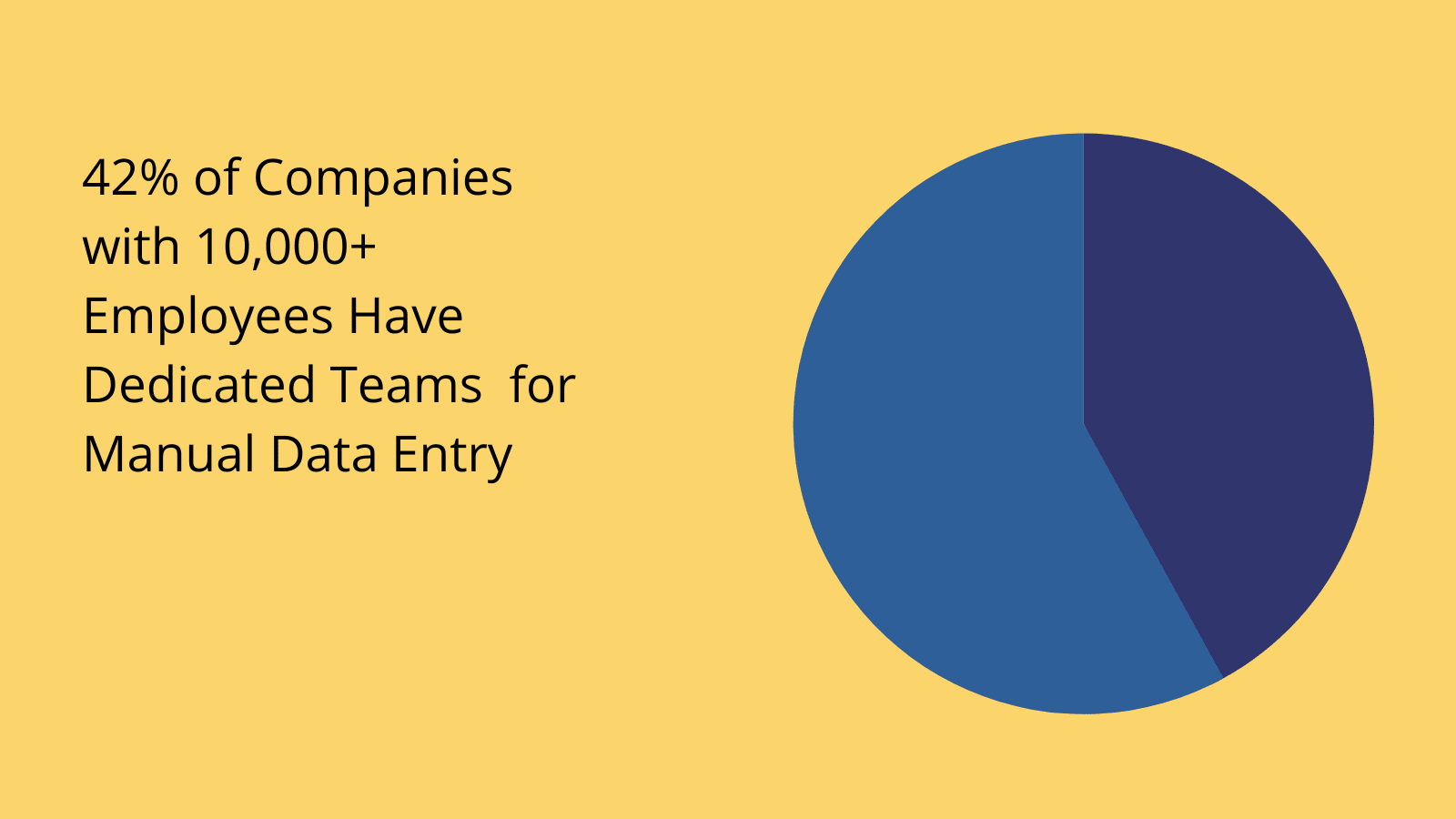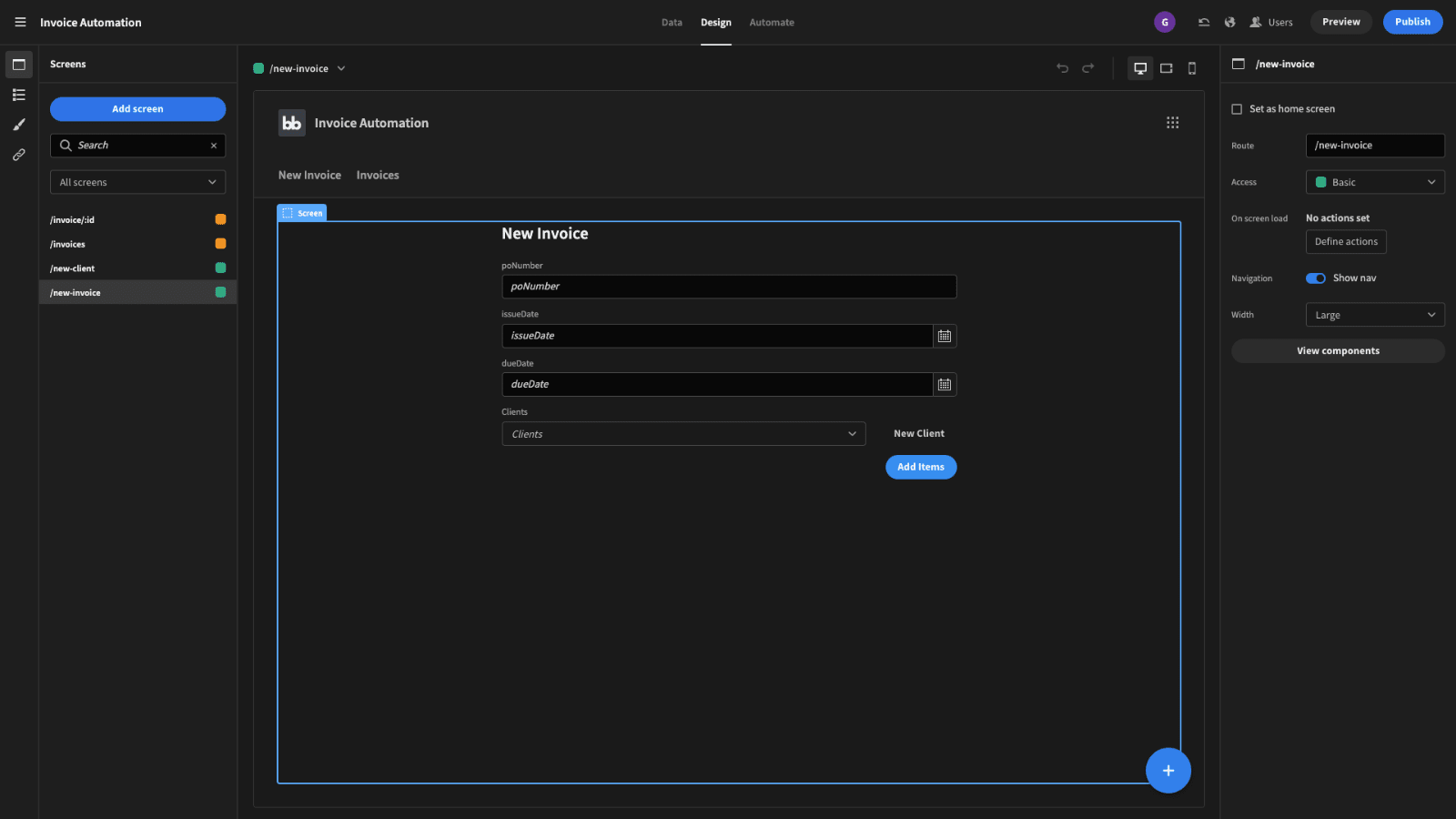Data Entry Automation | 5-Step Guide
Data entry is one of the most accessible routes to major efficiency savings. See, data entry is about the most repetitive, menial admin task there is. Despite this - it’s also one of the most common admin processes in all kinds of organizations.
In a lot of cases, if you have colleagues entering data manually all day, it’s indicative of a bigger problem with your data ops.
At least, it’s rare that manual data entry is the optimal solution - except in very specific, limited situations.
Today, we’re exploring why this is, what alternatives are available, and how you can use automation to achieve better results at a fraction of the cost.
We’ll also see how Budibase makes building streamlined, bespoke data automations a breeze.
But first, let’s start by exploring the basics.
What is data entry automation?
This isn’t as straightforward as it might initially appear. See, by its nature, data entry is a manual process. It’s when a human user takes information from one location and transfers it to another.
For example, taking pen-and-paper records, and adding them into a spreadsheet.
So, one definition of data entry automation would be any system that replicates these human interactions.
However, just a minute ago we said that manual data entry processes are often indicative of a deeper problem with how your business manages information. Therefore, straightforward replication is a bit like papering over the cracks.
We also need to think about how we can use automation to eliminate the need for data entry.
We’ll go over what this looks like in practice a bit later. For now, what’s important to recognize is that our point of departure should always be why we’re encountering a need for manual data entry and what the alternatives might be.
When is data entry needed?
At the most basic level, data entry workflows can crop up when we have data in one location that we need to move or copy to another - or if we have unrecorded data that we need to save or digitalize.
In other words, we’re dealing with two things:
- The information source.
- The target location for saving the data.
In between, we’ll also need a suitable UI for whoever is tasked with entering data into our target location.
This is normally an input form, a CRUD app, or a spreadsheet.
There are also associated tasks that we may or may not encounter alongside data entry - like quality control, validation, clean-ups, and more.

(ThriveMyWay )
The source of information is usually what breeds a need for manual processing. It’s common sense that it would be better to transfer data automatically. Typically, we end up with data entry processes when this is hard to implement.
This might be because of the source itself. For instance, if we’re dealing with physical media, sensor readings, legacy tools, or any other set of data that can’t easily be integrated with the target locations.
Or, we might end up with manual data entry processes because the team responsible doesn’t have the skills or resources to create an automated solution - or even if there’s a perception that this is the case.
It could even be the case that no one has bothered to come up with a better solution.
What can we automate?
Since we’re potentially dealing with different kinds of sources, targets, and colleagues, data entry processes can actually have a fairly large amount of internal variance.
So, it’s useful to lay out the kinds of constituent tasks that we can attack under the umbrella of data entry automation.
These include:
- Full-scale data transfer.
- Parsing information from physical or offline sources.
- Automatic validations.
- Quality control.
- Analysis.
- Anomaly detection.
- Backups.
- Document routing.
- Version control.
- And more.
This means that we’ll need to define the scope of any data entry automation project that we’re undertaking. Are we trying to automate the full end-to-end process - or just individual nodes?
This can depend on a bunch of different factors - including the time, resources, and expertise we can dedicate to our automation project - as well as the relative costs and benefits of automating different constituent tasks.
Of course, to make this kind of calculation, we need to understand the benefits and challenges that come along with data entry automation.
Check out our guide to invoice automation for one set of practical examples.
Benefits of data entry automation
We’ll start with the positives - since on the whole, these are going to outweigh the downsides.
The most obvious benefits relate to cost-effectiveness, efficiency, and productivity. Essentially, getting colleagues to enter data manually is almost never the most cost-effective way to achieve your aims.
Similarly, the more human interaction we have within our workflows, the greater the risk of associated errors - like wrong values, missed fields, or other simple human mixups.
With certain kinds of target locations, we’ll also open ourselves up to more serious errors when we over-rely on manual processing. For instance - if we have multiple users entering data into a single spreadsheet, things can quickly go very wrong.
Another huge upside of data entry automation is the impact we’ll see in terms of our levels of accuracy and consistency.
We’ll also see a much greater degree of scalability - which is crucial given the fact that businesses today process and handle larger volumes of data than ever before. Without automation, the only way to scale is to add more bums on seats.
And that’s not cheap.
Finally, there’s the issue of employee satisfaction. When we eliminate the need for manual data entry, we free our team up to work on more rewarding, cognate tasks - helping to boost their satisfaction at work.

(ThriveMyWay )
Check out our guide to making public forms .
Challenges of data entry automation
Of course, data entry automation won’t necessarily be all plain sailing either.
Indeed, like any other transformation project, we’ll almost inevitably encounter some trade-offs, compromises, or project roadblocks along the way. So, it’s important to be realistic about these.
First of all, we need to consider the up-front cost. See, it’s indisputable that data entry automation will work out cheaper in the medium-to-long term, but we’re still going to need to fork out to create solutions.
Depending on how you decide to go about automation, this could range from almost nothing - potentially into the tens of thousands. So, it pays to have a good grasp of your options. More on this later.
It’s also worth noting that there are certain use cases where manual data entry is preferable - or at least offers benefits over automated solutions. In particular, situations where we need a large amount of human intervention.
For example, if we’re dealing with particularly complex sentiment analysis or qualitative coding.
Finally, there’s the issue of process dependencies.
Unfortunately, it’s unlikely that much happens in your business in complete isolation - and this applies to something as simple as data entry too. Essentially, this is any situation where - in order to automate one process - you’ll also need to automate others.
This can either be because your desired solution won’t work otherwise - or that it won’t be worthwhile.
All the same, it’s important to state that none of these challenges are insurmountable. Rather - for the most part anyway - they’re considerations that might constrain or inform decision-making throughout your data entry automation project.
Next, we can think about what some of these decisions will look like.
Types of data entry automation
Onto some more practical stuff. As we alluded to earlier, there are actually several different routes we can go down for automating data entry.
These vary in terms of their complexity, technical requirements, scope, scale, and cost. We’ll also often see solutions that use several different types of automation in tandem.
Let’s think through some of the most common solution classes for data entry automation.
The ideal solution is often fully automated data pipelines. Basically, this means creating configurations for data to flow seamlessly across different nodes within your organization - with huge potential to eliminate the need for manual data entry.
However, this is often the most expensive and involved to set up.
Another popular option is leveraging robotic process automation (RPA). This means leveraging tools that allow you to teach bots to perform basic admin tasks by recording real users doing them on screen.
This is a cost-effective way to automate data entry with minimal technical barriers. The downside is that we’re relatively constrained in terms of use cases - with RPA only really being usable in highly regularized processes.
More recently low-code development has become more ubiquitous for automating all kinds of admin tasks.
There are a couple of key strands to this in the context of data entry automation.
One is building out automated form UIs. This can include contextual auto-complete, validation rules, user-triggered rules, and more.
Alternatively, we can use low-code to build targeted automation rules in the back end. For example, using API requests or webhooks to automate data transfer in a more discrete way than pipelines.
Take a look at our round-up of no-code tools for a different approach.
We’ll check out how Budibase handles this a little bit later.
How to automate data entry in 5 steps
Let’s think about how we can put this into practice. Like any other transformation project, what we need is a repeatable framework that takes account of the internal variations and decision points that we’re going to encounter.
Here’s our 5-step process for automating data entry workflows.
Analyze processes and set goals
First of all, we need to gain a clear understanding of where we are at present - and then figure out what we want to achieve through automation.
We can start by analyzing our existing data entry process.
The goal here is to figure out what’s working well and what’s suboptimal. The key here is to take a step back and think about what we’re trying to accomplish. That way, we can figure out the most effective way to do this.
Luckily, with data entry, this is usually pretty self-explanatory. Nine times out of ten, we have information somewhere that we want to move somewhere else.
We also need to think about the underlying goals and objectives for our automation project. This requires more in-depth analysis to determine exactly where we’re encountering excessive costs, unnecessary risks, inaccuracies, or other optimization opportunities.
Map your process
Next, we need to map out what our final process will look like. For now, we’re only worried about creating an abstract outline of this. We’ll figure out the specific automation interventions we’ll use in the next step.
The idea here is that we need to rationalize our actual process for moving data before we start automating it. Essentially, there’s no sense in throwing automations at a process that’s inherently inefficient.
In the first instance, we want to eliminate any redundant elements within our existing process - that is - any constituent tasks that don’t add value.
With what’s left, we can think about the most efficient way to achieve the more granular goals of each individual constituent task. This is where we can start thinking about specific automation actions.
Define automation actions
Now the fun stuff. Once we know exactly what we want to achieve and the specific elements of our data entry processes that we want to automate, we can start to think about the specific interventions that we’re going to use.
We’re balancing a few separate concerns here.
Essentially though, we’re always trying to achieve the maximum impact in terms of efficiency savings for the least cost and disruption.
We also want to take account of the technical resources that we can dedicate to data entry automation, as well as the scope of our project.
So, if we’ve got the full weight of our IT team behind us and we want to eliminate a whole range of data entry tasks, we might look to fully automated pipelines.
Otherwise, we’re probably going to end up relying on other techniques, like RPA, low-code, or even automation functionality within existing tools.
Check out our ultimate guide to data management software solutions .
Implementation
Once we know exactly what we want to automate and how, the only thing that remains is putting it into practice.
Of course, there are a few separate strands to the implementation of any kind of digital transformation project.
Broadly speaking, we can think about these in terms of technical, cultural, and operational issues.
Under the technical umbrella, we naturally have the issue of actually creating our solutions. We’ll also need to consider non-functional elements - including hosting, UIs, API connections, and any other peripheral needs.
The cultural and organizational piece is arguably even trickier.
This includes anything that relates to training, change management, setting expectations, and even HR-related issues, like redeploying colleagues.
We also need to consider the operations around how we deploy our new solutions - with a view to minimizing redundancy, service disruption, or other confusion during the changeover period.
Monitoring and review
Finally, once our new data entry automation system is live, we have two priorities:
- Supporting it.
- Monitoring our success to see what works and what we can improve upon.
The first point is pretty self-explanatory - as well as being closely linked to the specifics of your particular solutions. So - we won’t dwell too closely on this.
The monitoring and review piece is slightly easier to generalize around.
Remember, we set goals for each individual aspect of our data entry automation project earlier - both at a descriptive level and in terms of our underlying business aims.
Now, we want to combine this with the reality of our solution as it’s performing in-situ.
We have two core goals:
- Where we’re failing to meet our goals, figuring out why - and how we can resolve any underlying issues.
- Where we’re succeeding, looking for lessons that we can carry across to improve other aspects of our data entry automation - or even other business processes.

Turn data into action with Budibase
Budibase is the fast, cost-effective way to build custom solutions for all kinds of internal processes. There’s never been an easier way to build professional applications, with minimal custom code.
Here’s what makes our platform tick.
Our open-source, low-code platform
At Budibase, we’re on a mission to help teams turn data into action. With extensive data connectivity, leading extensibility, and simple yet powerful design tools, there’s never been an easier way to create all sorts of web applications.
Check out our features overview to learn more.
Optional self-hosting
Budibase is the perfect partner for security-conscious organizations. We offer self-hosting through Kubernetes, Docker, N8N, Portainer, Digital Ocean, and more.
We’ve also got our own cloud-based platform. Check out our pricing page to learn more about both options.
Extensive data support
Budibase is miles ahead of the pack for external data support. We offer dedicated connectors for SQL, Postgres, S3, Oracle, Google Sheets, Mongo, Arango, Couch, REST API, and many more.
We’ve even got our own intuitive built-in database.
Role-base access control
Use Budibase’s built-in RBAC to seamlessly marry security with usability. Add users to predefined roles and grant access at the level of screens, components, data sources, queries, or automation runs.
We even offer free SSO.
Flexible automations
Budibase makes automating all kinds of workflows a breeze. Our built-in automation editor features a range of nestable, configurable triggers and actions, for all kinds of logic and events.
You can even leverage external platforms using Zapier, REST, Webhooks, and more.
Custom plug-ins
We won’t be beaten on extensibility. Use our dedicated CLI tools to build your own components, automation rules, or data sources - or add our community contributions to your tenant at the press of a button.
Check out our plugins docs to learn more.
50+ free application templates
Budibase is the ideal solution for building all kinds of use cases. To prove it, we’ve created more than 50 free, deployment-ready, and fully customizable application templates .
To start building internal tools the fast, easy way, sign up to Budibase today for free.